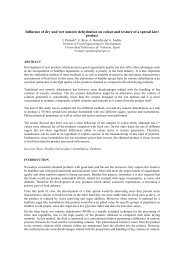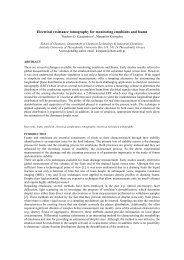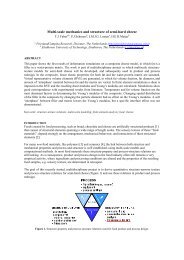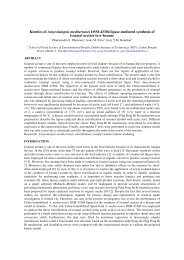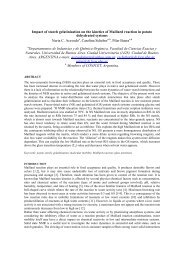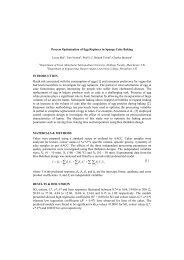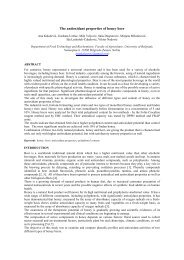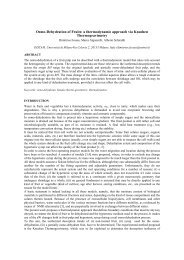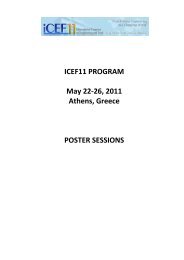Effects of edible chitosan- linseed mucilage coating on quality and ...
Effects of edible chitosan- linseed mucilage coating on quality and ...
Effects of edible chitosan- linseed mucilage coating on quality and ...
You also want an ePaper? Increase the reach of your titles
YUMPU automatically turns print PDFs into web optimized ePapers that Google loves.
<str<strong>on</strong>g>Effects</str<strong>on</strong>g> <str<strong>on</strong>g>of</str<strong>on</strong>g> <str<strong>on</strong>g>edible</str<strong>on</strong>g> <str<strong>on</strong>g>chitosan</str<strong>on</strong>g>- <str<strong>on</strong>g>linseed</str<strong>on</strong>g> <str<strong>on</strong>g>mucilage</str<strong>on</strong>g> <str<strong>on</strong>g>coating</str<strong>on</strong>g> <strong>on</strong> <strong>quality</strong> <strong>and</strong> shelf life <str<strong>on</strong>g>of</str<strong>on</strong>g> freshcut<br />
strawberry<br />
Laura Eugenia Pérez Cabrera a , Gloria Cristina Díaz Narváez a , Alberto Tecante Cor<strong>on</strong>el b , Chelo G<strong>on</strong>zález<br />
Martínez c<br />
a Department <str<strong>on</strong>g>of</str<strong>on</strong>g> Food Technology, Universidad Autónoma de Aguascalientes, Aguascalientes, México<br />
(leperez@correo.uaa.mx)<br />
b Department <str<strong>on</strong>g>of</str<strong>on</strong>g> Food <strong>and</strong> Biotechnology, Universidad Naci<strong>on</strong>al Autónoma de México, Ciudad de México<br />
c Department <str<strong>on</strong>g>of</str<strong>on</strong>g> Food Technology, Universidad Politécnica de Valencia, Valencia, Spain<br />
ABSTRACT<br />
The increment <strong>on</strong> c<strong>on</strong>sumer dem<strong>and</strong>s <str<strong>on</strong>g>of</str<strong>on</strong>g> high <strong>quality</strong> foods <strong>and</strong> the c<strong>on</strong>cern <str<strong>on</strong>g>of</str<strong>on</strong>g> the envir<strong>on</strong>ment deteriorati<strong>on</strong><br />
have forced to the food processors to reduce disposable packaging waste <strong>and</strong> have led to increase research<br />
interest <strong>on</strong> <str<strong>on</strong>g>edible</str<strong>on</strong>g> films <strong>and</strong> <str<strong>on</strong>g>coating</str<strong>on</strong>g>s. Edible <str<strong>on</strong>g>coating</str<strong>on</strong>g>s provide an additi<strong>on</strong>al protective <str<strong>on</strong>g>coating</str<strong>on</strong>g> fruits <strong>and</strong><br />
vegetables minimally processed, which is equivalent to the technological impact <str<strong>on</strong>g>of</str<strong>on</strong>g> a modified atmosphere,<br />
representing an alternative to c<strong>on</strong>servati<strong>on</strong>, coupled with an envir<strong>on</strong>ment friendly method. The objective <str<strong>on</strong>g>of</str<strong>on</strong>g><br />
this study was evaluated the effectiveness <str<strong>on</strong>g>of</str<strong>on</strong>g> <str<strong>on</strong>g>edible</str<strong>on</strong>g> <str<strong>on</strong>g>chitosan</str<strong>on</strong>g>-<str<strong>on</strong>g>linseed</str<strong>on</strong>g> <str<strong>on</strong>g>mucilage</str<strong>on</strong>g> <str<strong>on</strong>g>coating</str<strong>on</strong>g>s to extend the shelflife<br />
<str<strong>on</strong>g>of</str<strong>on</strong>g> strawberries minimally processed. Edible <str<strong>on</strong>g>coating</str<strong>on</strong>g>s made with flaxseed <str<strong>on</strong>g>mucilage</str<strong>on</strong>g>, <str<strong>on</strong>g>chitosan</str<strong>on</strong>g> 1%, lactic<br />
acid 0.5% <strong>and</strong> Glycerol 0.6%. It dipped strawberries, washed <strong>and</strong> sanitized in the <str<strong>on</strong>g>edible</str<strong>on</strong>g> <str<strong>on</strong>g>coating</str<strong>on</strong>g>s <strong>and</strong> stored<br />
at 10 ° C to facilitate dry, then were packed in polystyrene bags at 4 ° C. Uncoated strawberries were used as<br />
a blank <strong>and</strong> covered strawberries without <str<strong>on</strong>g>chitosan</str<strong>on</strong>g> in the formulati<strong>on</strong> <strong>and</strong> c<strong>on</strong>trol. Were analyzed respirati<strong>on</strong><br />
rate, colour, decay rate, texture, microbial growth <strong>and</strong> weight loss at 0 days <strong>and</strong> during storage (20 days). The<br />
<str<strong>on</strong>g>edible</str<strong>on</strong>g> <str<strong>on</strong>g>coating</str<strong>on</strong>g> samples with <str<strong>on</strong>g>chitosan</str<strong>on</strong>g> in its formulati<strong>on</strong>, have a significantly lower compared with c<strong>on</strong>trol RR<br />
to 0 days. The colour <strong>and</strong> firmness <str<strong>on</strong>g>of</str<strong>on</strong>g> the strawberries with <str<strong>on</strong>g>edible</str<strong>on</strong>g> <str<strong>on</strong>g>coating</str<strong>on</strong>g>s to the end <str<strong>on</strong>g>of</str<strong>on</strong>g> storage showed less<br />
changes compared to day 0, weight loss was significantly higher for c<strong>on</strong>trol samples <strong>and</strong> the decay rate<br />
showed that <str<strong>on</strong>g>edible</str<strong>on</strong>g> <str<strong>on</strong>g>coating</str<strong>on</strong>g>s c<strong>on</strong>taining strawberries have less damage Chitosan expressed as tissue<br />
desiccati<strong>on</strong>, presence <str<strong>on</strong>g>of</str<strong>on</strong>g> fungi <strong>and</strong> collapse. Coating applicati<strong>on</strong> with <str<strong>on</strong>g>chitosan</str<strong>on</strong>g> in its formulati<strong>on</strong> reduces<br />
significantly microbial growth in fresh-cut strawberry. From these observati<strong>on</strong>s, it appears that the<br />
experimental <str<strong>on</strong>g>coating</str<strong>on</strong>g>s had a positive effect <strong>on</strong> maintaining <strong>quality</strong>. However, a l<strong>on</strong>ger testing period is<br />
needed to re-enforce the findings from this study.<br />
Keywords: <str<strong>on</strong>g>linseed</str<strong>on</strong>g> <str<strong>on</strong>g>mucilage</str<strong>on</strong>g>; <str<strong>on</strong>g>chitosan</str<strong>on</strong>g>; strawberry; shelf life; <strong>quality</strong><br />
INTRODUCTION<br />
The use <str<strong>on</strong>g>of</str<strong>on</strong>g> <str<strong>on</strong>g>edible</str<strong>on</strong>g> <str<strong>on</strong>g>coating</str<strong>on</strong>g>s represents <strong>on</strong>e <str<strong>on</strong>g>of</str<strong>on</strong>g> the important methods being used for preserving <strong>quality</strong> <str<strong>on</strong>g>of</str<strong>on</strong>g><br />
minimally processed produce; several mechanisms are involved in extending the shelf-life <str<strong>on</strong>g>of</str<strong>on</strong>g> fruits <strong>and</strong><br />
vegetables. Edible <str<strong>on</strong>g>coating</str<strong>on</strong>g>s have been traditi<strong>on</strong>ally used to improve food appearance <strong>and</strong> maintain <strong>quality</strong><br />
because they are c<strong>on</strong>sidered envir<strong>on</strong>mentally friendly [1]. Coating films can act as barriers to moisture <strong>and</strong><br />
oxygen during processing, h<strong>and</strong>ling <strong>and</strong> storage [2]. Moreover, they can retard food deteriorati<strong>on</strong> by<br />
inhibiting the growth <str<strong>on</strong>g>of</str<strong>on</strong>g> microorganisms, due to their natural intrinsic activity or to the incorporati<strong>on</strong> <str<strong>on</strong>g>of</str<strong>on</strong>g><br />
antimicrobial compounds [3]. Normally, <str<strong>on</strong>g>edible</str<strong>on</strong>g> films are made <str<strong>on</strong>g>of</str<strong>on</strong>g> proteins or polysaccharides that can also<br />
help to maintain moisture, thereby improving shelf life. However, the hydrophilic nature <str<strong>on</strong>g>of</str<strong>on</strong>g> these compounds<br />
limits their ability to provide desired <str<strong>on</strong>g>edible</str<strong>on</strong>g> film functi<strong>on</strong>s. Current approaches to extend functi<strong>on</strong>al <strong>and</strong><br />
mechanical properties <str<strong>on</strong>g>of</str<strong>on</strong>g> these films include (i) incorporati<strong>on</strong> <str<strong>on</strong>g>of</str<strong>on</strong>g> hydrophobic compounds such as lipids to<br />
improve their resistance to water [4], (ii) optimizati<strong>on</strong> <str<strong>on</strong>g>of</str<strong>on</strong>g> the interacti<strong>on</strong> between polymers (protein-protein<br />
interacti<strong>on</strong>s, charge–charge electrostatic complexes between proteins or polysaccharides) <strong>and</strong> (iii) crosslinking<br />
or functi<strong>on</strong>alizati<strong>on</strong> through physical, chemical, or enzymatic treatments [5].<br />
Strawberries are a n<strong>on</strong>-climacteric fruits with a very short postharvest life. Strawberries are especially<br />
perishable fruits, being susceptible to mechanical injury, desiccati<strong>on</strong>, decay <strong>and</strong> physiological disorders<br />
during storage [6]. Loss <str<strong>on</strong>g>of</str<strong>on</strong>g> <strong>quality</strong> in this fruit is mostly due to its relatively high metabolic activity <strong>and</strong><br />
sensitivity to fungal decay
Linseed <str<strong>on</strong>g>mucilage</str<strong>on</strong>g> is capable to film-forming [7]; the functi<strong>on</strong>ality <str<strong>on</strong>g>of</str<strong>on</strong>g> <str<strong>on</strong>g>linseed</str<strong>on</strong>g> <str<strong>on</strong>g>mucilage</str<strong>on</strong>g> is similar to that <str<strong>on</strong>g>of</str<strong>on</strong>g><br />
gum arabic [8]. Linseed <str<strong>on</strong>g>mucilage</str<strong>on</strong>g> <strong>and</strong> <str<strong>on</strong>g>linseed</str<strong>on</strong>g> <str<strong>on</strong>g>mucilage</str<strong>on</strong>g>-based <str<strong>on</strong>g>edible</str<strong>on</strong>g> <str<strong>on</strong>g>coating</str<strong>on</strong>g>s have been used in fresh-cut<br />
cucumber resulting from better preservati<strong>on</strong> did not induce significant changes in physicochemical <strong>quality</strong><br />
throughout cold storage, but they did result in a better preservati<strong>on</strong> <str<strong>on</strong>g>of</str<strong>on</strong>g> the coated samples mechanical<br />
properties <strong>and</strong> colour during storage. From these observati<strong>on</strong>s, it appears that the experimental <str<strong>on</strong>g>coating</str<strong>on</strong>g>s had a<br />
positive effect <strong>on</strong> maintaining <strong>quality</strong> [6]. However <str<strong>on</strong>g>linseed</str<strong>on</strong>g> <str<strong>on</strong>g>mucilage</str<strong>on</strong>g>-based <str<strong>on</strong>g>edible</str<strong>on</strong>g> <str<strong>on</strong>g>coating</str<strong>on</strong>g>s does not present a<br />
significant reducti<strong>on</strong> in antimicrobial activity, that is why the combinati<strong>on</strong> with antimicrobial agents is<br />
necessary, such as <str<strong>on</strong>g>chitosan</str<strong>on</strong>g>.<br />
Chitosan (poly β-(1,4)N-acetyl-D-glucosamine) polymer is industrially produced by chemical deacetylati<strong>on</strong><br />
<str<strong>on</strong>g>of</str<strong>on</strong>g> the chitin found in arthropod exoskelet<strong>on</strong>s. This biopolymer can also be obtained directly from the cell<br />
wall <str<strong>on</strong>g>of</str<strong>on</strong>g> some plant-pathogenic fungi. Chitosan <strong>and</strong> its derivatives have been shown to inhibit the growth <str<strong>on</strong>g>of</str<strong>on</strong>g> a<br />
wide range <str<strong>on</strong>g>of</str<strong>on</strong>g> fungi <strong>and</strong> trigger defensive mechanisms in plants <strong>and</strong> fruits against infecti<strong>on</strong>s caused by<br />
several pathogens. Chitosan possesses excellent film-forming properties <strong>and</strong> can be applied as an <str<strong>on</strong>g>edible</str<strong>on</strong>g><br />
surface <str<strong>on</strong>g>coating</str<strong>on</strong>g> to fruits <strong>and</strong> vegetables. Chitosan <str<strong>on</strong>g>coating</str<strong>on</strong>g>s have been reported to limit fungal decay <strong>and</strong> delay<br />
the ripening <str<strong>on</strong>g>of</str<strong>on</strong>g> several commodities, including strawberry [9]. In additi<strong>on</strong>, <str<strong>on</strong>g>chitosan</str<strong>on</strong>g> is an ideal preservative<br />
<str<strong>on</strong>g>coating</str<strong>on</strong>g> for fresh fruits because <str<strong>on</strong>g>of</str<strong>on</strong>g> its biochemical properties [9] <strong>and</strong> its use in food is particularly promising<br />
because <str<strong>on</strong>g>of</str<strong>on</strong>g> its ‘‘biocompatibility’’, n<strong>on</strong>-toxicity <strong>and</strong> antimicrobial acti<strong>on</strong>. The objective <str<strong>on</strong>g>of</str<strong>on</strong>g> this study was<br />
evaluated the effectiveness <str<strong>on</strong>g>of</str<strong>on</strong>g> <str<strong>on</strong>g>edible</str<strong>on</strong>g> <str<strong>on</strong>g>chitosan</str<strong>on</strong>g>-<str<strong>on</strong>g>linseed</str<strong>on</strong>g> <str<strong>on</strong>g>mucilage</str<strong>on</strong>g> <str<strong>on</strong>g>coating</str<strong>on</strong>g>s to extend the shelf-life <str<strong>on</strong>g>of</str<strong>on</strong>g><br />
strawberries minimally processed.<br />
MATERIALS & METHODS<br />
Strawberries (Fragaria ananassa cv. Albi<strong>on</strong>) were purchased from a producer-provider under the trademark<br />
HamBerry® (Aguascalientes, México) <strong>and</strong> were inspected for no sign <str<strong>on</strong>g>of</str<strong>on</strong>g> physical damage, disease <strong>and</strong> visual<br />
decay. Strawberries were sorted to select those with 2/3 <str<strong>on</strong>g>of</str<strong>on</strong>g> their red colour <strong>and</strong> being <str<strong>on</strong>g>of</str<strong>on</strong>g> uniform size.<br />
Mucilaginous material was extracted from brown <str<strong>on</strong>g>linseed</str<strong>on</strong>g> (Linum usitatissimum) purchased from a local<br />
wholesale distributor by mixing the seed with distilled water (1:20 w/v), stirring the seed-water mixture for 1<br />
h at 40°C. The <str<strong>on</strong>g>mucilage</str<strong>on</strong>g> extract was separated from seed by filtrati<strong>on</strong> trough a mesh-using vacuum <strong>and</strong> to<br />
obtain polymer the mucilaginous material was ethanol precipitate (1:1.5 v/v) <strong>and</strong> recovered by evaporati<strong>on</strong> <str<strong>on</strong>g>of</str<strong>on</strong>g><br />
the solvent <strong>and</strong> drying.<br />
Coating soluti<strong>on</strong>s FA, FB <strong>and</strong> FC were prepared by dissolving 1.5, 1.2 <strong>and</strong> 1.0% w/v <str<strong>on</strong>g>of</str<strong>on</strong>g> <str<strong>on</strong>g>mucilage</str<strong>on</strong>g> polymer in<br />
aqueous dispersi<strong>on</strong>, <str<strong>on</strong>g>chitosan</str<strong>on</strong>g> with a deacetylati<strong>on</strong> degree <str<strong>on</strong>g>of</str<strong>on</strong>g> 75% (1% w/v) (Sigma-Aldrich N. C3646), lactic<br />
acid 0.5% (Hycel) <strong>and</strong> Glycerol 0.6% (Fermot). The pH <str<strong>on</strong>g>of</str<strong>on</strong>g> the formulati<strong>on</strong>s <str<strong>on</strong>g>of</str<strong>on</strong>g> <str<strong>on</strong>g>edible</str<strong>on</strong>g> <str<strong>on</strong>g>coating</str<strong>on</strong>g>s were ~ 4.5-<br />
5.2.<br />
Strawberries were washed <strong>and</strong> sanitized by immersi<strong>on</strong> into a 4 mL/10 l <str<strong>on</strong>g>of</str<strong>on</strong>g> Nic<strong>on</strong>-PQ® for 3 min. After<br />
draining, the fresh-cut strawberries were dipped in the <str<strong>on</strong>g>coating</str<strong>on</strong>g>s soluti<strong>on</strong>s FA, FB <strong>and</strong> F2 for 8 min. Uncoated<br />
strawberries were used as a blank <strong>and</strong> coated strawberries without <str<strong>on</strong>g>chitosan</str<strong>on</strong>g> in the formulati<strong>on</strong> was c<strong>on</strong>trol.<br />
After the <str<strong>on</strong>g>coating</str<strong>on</strong>g>s process, samples were dried by natural c<strong>on</strong>vecti<strong>on</strong> for 2 h at 12 °C <strong>and</strong> were packed <strong>and</strong><br />
stored in polystyrene bags at 4 ° C.<br />
Weight loss was expressed as the percentage loss <str<strong>on</strong>g>of</str<strong>on</strong>g> the initial total weight. For each measurement, 25 fruits<br />
corresp<strong>on</strong>ding to each treatment were used <strong>and</strong> the experiment was performed in triplicate.<br />
Respirati<strong>on</strong> rate was determined by using the static method. Eight strawberries were placed in hermetically<br />
sealed 875 ml glass jars <strong>and</strong> kept at 10 °C. After 1 h <str<strong>on</strong>g>of</str<strong>on</strong>g> enclosure, a 100 µl sample was withdrawn from the<br />
headspace <strong>and</strong> analyzed for O 2 <strong>and</strong> CO 2 using a gas analyser (PBI Dansensor). Respirati<strong>on</strong> rate (RR i , mg kg −1<br />
h −1 ) <str<strong>on</strong>g>of</str<strong>on</strong>g> the samples in terms <str<strong>on</strong>g>of</str<strong>on</strong>g> CO 2 generati<strong>on</strong> <strong>and</strong> O 2 c<strong>on</strong>sumpti<strong>on</strong> was determined from the slope <str<strong>on</strong>g>of</str<strong>on</strong>g> the<br />
fitted linear equati<strong>on</strong>, as described by [10].
Strawberry external colour was evaluated with a colorimeter (Minolta CR-400) CIE L*a*b* coordinates were<br />
recorded using C illuminant <strong>and</strong> a 2° St<strong>and</strong>ard Observer as a reference system. Three readings were taken at<br />
different locati<strong>on</strong>s <strong>on</strong> each strawberry, during storage at 0, 5, 10, 15 <strong>and</strong> 20 days<br />
Mechanical properties were measured by using a Texture Analyser (TA-XT-plus, Stable Micro Systems),<br />
using a 75 mm diameter plate probe. Strawberry samples were 95% compressed at a 0.2 mm/s deformati<strong>on</strong><br />
rate. Force <strong>and</strong> distance at the rupture point were used as mechanical parameters.<br />
Decay rate (lost <str<strong>on</strong>g>of</str<strong>on</strong>g> visual <strong>quality</strong>, arbitrary scale) <str<strong>on</strong>g>of</str<strong>on</strong>g> strawberries that showed any sign <str<strong>on</strong>g>of</str<strong>on</strong>g> surface mycelia<br />
development, dehydrati<strong>on</strong>, spots, colour changes, tissue damage, tissue collapse were c<strong>on</strong>sidered decayed.<br />
Results were expressed as percentage <str<strong>on</strong>g>of</str<strong>on</strong>g> damaged strawberries.<br />
Microbial growth was determined <str<strong>on</strong>g>of</str<strong>on</strong>g> 10 g <str<strong>on</strong>g>of</str<strong>on</strong>g> strawberries was removed from each package <strong>and</strong> homogenized<br />
with 90 mL sterile water in a sterile plastic bag, by use <str<strong>on</strong>g>of</str<strong>on</strong>g> a Seaward 400 Stomacher for 3 min. Decimal<br />
diluti<strong>on</strong>s were then prepared <strong>and</strong> plated <strong>on</strong>to appropriate media. The media <strong>and</strong> the incubati<strong>on</strong> c<strong>on</strong>diti<strong>on</strong>s<br />
were as follows: mesophilic aerobic count (Plate count agar, Biox<strong>on</strong>), incubated at 35±1 °C for 48 h for total<br />
coliforms (Violet red bile agar, Biox<strong>on</strong>) incubated at 37±1 °C for 24 h <strong>and</strong> for moulds <strong>and</strong> yeasts (Potato<br />
dextrose agar, Biox<strong>on</strong>) incubated at 25±1 ◦C for 72 h. All microbial counts were reported as log CFU/g<br />
(col<strong>on</strong>y forming units per gram <str<strong>on</strong>g>of</str<strong>on</strong>g> sample). The cell load data <str<strong>on</strong>g>of</str<strong>on</strong>g> each microbial group, collected during the<br />
storage <str<strong>on</strong>g>of</str<strong>on</strong>g> the products, were modelled according to Gompertz equati<strong>on</strong> modified by [11] during storage (0,<br />
5, 10, 15, 20 days):<br />
{ − exp[( µ e / A)(<br />
λ − ) 1] }<br />
y = k + Aexp max<br />
t +<br />
(1)<br />
where y is the log[CFU/g], k is the initial level <str<strong>on</strong>g>of</str<strong>on</strong>g> the dependent variable to be modelled, A is the maximum<br />
increase <str<strong>on</strong>g>of</str<strong>on</strong>g> bacterial load attained at the stati<strong>on</strong>ary phase, µ max is the maximal growth rate (∆log<br />
[CFU/g]/day), λ is the lag time (days) <strong>and</strong> t is the time.<br />
RESULTS & DISCUSSION<br />
Weight loss was expressed as percentage loss <str<strong>on</strong>g>of</str<strong>on</strong>g> the initial total weight (Figure 1) all samples showed a<br />
progressive loss <str<strong>on</strong>g>of</str<strong>on</strong>g> weight during storage, after the fifth day <str<strong>on</strong>g>of</str<strong>on</strong>g> storage weight losses for strawberries coated<br />
with <str<strong>on</strong>g>chitosan</str<strong>on</strong>g>-<str<strong>on</strong>g>linseed</str<strong>on</strong>g> <str<strong>on</strong>g>mucilage</str<strong>on</strong>g> (FA, FB & FC) were significantly lower (p
metabolic pathways <str<strong>on</strong>g>of</str<strong>on</strong>g> coated strawberries. The additi<strong>on</strong> <str<strong>on</strong>g>of</str<strong>on</strong>g> this type <str<strong>on</strong>g>of</str<strong>on</strong>g> <str<strong>on</strong>g>coating</str<strong>on</strong>g> is likely to modify the<br />
internal atmosphere without causing anaerobic respirati<strong>on</strong>, since <str<strong>on</strong>g>chitosan</str<strong>on</strong>g>-<str<strong>on</strong>g>linseed</str<strong>on</strong>g> <str<strong>on</strong>g>mucilage</str<strong>on</strong>g> <str<strong>on</strong>g>edible</str<strong>on</strong>g> are more<br />
selectively permeable to O 2 than to CO 2 [9].<br />
2.5<br />
2<br />
Respiratory quotient<br />
1.5<br />
1<br />
0.5<br />
0<br />
Blank C<strong>on</strong>trol FA FB FC<br />
Sample<br />
Figure 3. Visual lost <strong>quality</strong> <str<strong>on</strong>g>of</str<strong>on</strong>g> coated, blank <strong>and</strong> c<strong>on</strong>trol strawberries stored at 10 ◦C.<br />
One <str<strong>on</strong>g>of</str<strong>on</strong>g> the best parameters to describe the variati<strong>on</strong> <str<strong>on</strong>g>of</str<strong>on</strong>g> colour is the colour differences (∆E*), as it shows the<br />
total change in all parameters L *, a * b *, (Figure 4) the changes during storage were visually perceptible to<br />
an end. Uncoated fruits were darkens, skin colour becomes less chromatic <strong>and</strong> surface browning develops.<br />
Firmness (Figure 5) significantly decreased during storage for all samples, these changes, which can be<br />
attributed to tissue senescence <strong>and</strong> cell wall breakdown, as well as to the sample water loss, were<br />
significantly less marked in coated strawberries.<br />
14<br />
2.0<br />
12<br />
∆E*<br />
10<br />
8<br />
6<br />
Firmness (N)<br />
1.5<br />
1.0<br />
4<br />
0.5<br />
2<br />
0<br />
Blank C<strong>on</strong>trol FA FB FC<br />
Sample<br />
0.0<br />
FA FB FC Blank C<strong>on</strong>trol<br />
0 5 10 15 20<br />
Storage time (days)<br />
Figure 4. Colour difference <str<strong>on</strong>g>of</str<strong>on</strong>g> strawberries coated,<br />
blank <strong>and</strong> c<strong>on</strong>trol at end <str<strong>on</strong>g>of</str<strong>on</strong>g> storage time.<br />
Figure 5. Firmness strawberries coated, blank<br />
<strong>and</strong> c<strong>on</strong>trol during storage time.<br />
Under refrigerati<strong>on</strong>, the antimicrobial activity <str<strong>on</strong>g>of</str<strong>on</strong>g> <str<strong>on</strong>g>chitosan</str<strong>on</strong>g> seemed to influence significantly the growth <str<strong>on</strong>g>of</str<strong>on</strong>g><br />
mesophilic bacteria. Edible <str<strong>on</strong>g>coating</str<strong>on</strong>g>s <str<strong>on</strong>g>chitosan</str<strong>on</strong>g>-based displayed a str<strong>on</strong>g inhibiti<strong>on</strong> for all microbial groups; the<br />
presence <str<strong>on</strong>g>of</str<strong>on</strong>g> <str<strong>on</strong>g>chitosan</str<strong>on</strong>g> <strong>on</strong> coated strawberries were significant difference between uncoated or c<strong>on</strong>trol<br />
strawberries (Table 1.).<br />
Table 1. Gompertz parameters <str<strong>on</strong>g>of</str<strong>on</strong>g> mesophilic bacteria<br />
Sample<br />
Gompertz parameters a,c<br />
A µ max λ R 2<br />
Blank 6.9 3.0 0.45 0.995<br />
C<strong>on</strong>trol 4.3 7.0 0.39 0.998<br />
FA 1.7 2.5 0.18 0.995<br />
FB 1.3 2.6 0.21 0.997<br />
FC 1.5 3.0 0.15 0.989
CONCLUSION<br />
The use <str<strong>on</strong>g>of</str<strong>on</strong>g> <str<strong>on</strong>g>edible</str<strong>on</strong>g> <str<strong>on</strong>g>chitosan</str<strong>on</strong>g>-<str<strong>on</strong>g>linseed</str<strong>on</strong>g> <str<strong>on</strong>g>mucilage</str<strong>on</strong>g> applied at strawberry fruits is recommended to c<strong>on</strong>trol browning,<br />
firmness lost, microbial growth <strong>and</strong> decay in strawberry fruit in combinati<strong>on</strong> with other methods, i.e. low<br />
temperature <strong>and</strong> suitable packaging.<br />
REFERENCES<br />
[1] Khwaldia K. Perez C. Ban<strong>on</strong> S. Desobry S. & Hardy J. 2004. Milk proteins for <str<strong>on</strong>g>edible</str<strong>on</strong>g> films <strong>and</strong> <str<strong>on</strong>g>coating</str<strong>on</strong>g>s. Critical<br />
Review in Food Science <strong>and</strong> Nutriti<strong>on</strong>, 44, 239−251.<br />
[2] Xu W. T. Huang K. L. Guo F. Qu W. Yang J. J. Liang Z. H. 2007. Postharvest grapefruit seed extract <strong>and</strong> <str<strong>on</strong>g>chitosan</str<strong>on</strong>g><br />
treatments <str<strong>on</strong>g>of</str<strong>on</strong>g> table grapes to c<strong>on</strong>trol Botrytis cinerea. Postharvest Biolology <strong>and</strong> Technology, 46, 86−94.<br />
[3] Cha D. S. & Chinnan M. S. 2004. Biopolymer-based antimicrobial packaging: A review. Critical Review in Food<br />
Science <strong>and</strong> Nutriti<strong>on</strong>, 44, 223−237.<br />
[4] McHugh T. H. & Krochta J. M. 1994. Milk-protein-based <str<strong>on</strong>g>edible</str<strong>on</strong>g> films <strong>and</strong> <str<strong>on</strong>g>coating</str<strong>on</strong>g>s. Food Technolology, 48,<br />
97−103.<br />
[5] Pierro P. D. Chico B. Villal<strong>on</strong>ga R. Mariniello L. Damiao A. E. Masi P. 2006. Chitosan-Whey protein <str<strong>on</strong>g>edible</str<strong>on</strong>g> films<br />
produced in the absence or presence <str<strong>on</strong>g>of</str<strong>on</strong>g> transglutaminase: Analysis <str<strong>on</strong>g>of</str<strong>on</strong>g> their mechanical <strong>and</strong> barrier properties.<br />
Biomacromolecules, 7, 744−749.<br />
[6] Tournas V. H. & Katsoudas E. 2005. Mould <strong>and</strong> yeast flora in fresh berries, grapes <strong>and</strong> citrus fruits. Internati<strong>on</strong>al<br />
Journal <str<strong>on</strong>g>of</str<strong>on</strong>g> Food Microbiology, 105, 11−17.<br />
[7] Hernández C., Pérez-Cabrera L. E. & G<strong>on</strong>zález-Martínez C. 2010. Development <str<strong>on</strong>g>of</str<strong>on</strong>g> Linseed-Mucilage Edible<br />
Coatings <strong>and</strong> its Applicati<strong>on</strong> to Extend Fresh-cut Cucumber Shelf-life. In Regalado C. & García B. E. (Eds.).<br />
Innovati<strong>on</strong>s in Food Science <strong>and</strong> Food Biotechnology in Developing Countries. Inc. AMECA, A. C. Queretaro,<br />
Mexico. p 321-334.<br />
[8] Mazza G. & Biliaderis C. G. 1989. Functi<strong>on</strong>al properties <str<strong>on</strong>g>of</str<strong>on</strong>g> flax <str<strong>on</strong>g>mucilage</str<strong>on</strong>g>. Journal <str<strong>on</strong>g>of</str<strong>on</strong>g> Food Science, 54, 1302-1305.<br />
[9] El Ghaouth A. P<strong>on</strong>nampalam R. Castaigne F. & Arul J. 1992. Chitosan <str<strong>on</strong>g>coating</str<strong>on</strong>g> to extend the storage life <str<strong>on</strong>g>of</str<strong>on</strong>g><br />
tomatoes. Horticultural Science, 27, 1016–1018.<br />
[10] F<strong>on</strong>seca S.C. Oliveira F.A.R. Jeffrey K. Brecha J.K. 2002. Modelling respirati<strong>on</strong> rate <str<strong>on</strong>g>of</str<strong>on</strong>g> fresh fruits <strong>and</strong> vegetables<br />
for modified atmosphere packages: a review. Journal <str<strong>on</strong>g>of</str<strong>on</strong>g> Food Engineering, 52, 99–119.<br />
[11] Zwietering M.H. J<strong>on</strong>genberge I. Rombouts F.M. van’tRiet K. 1990. Modelling <str<strong>on</strong>g>of</str<strong>on</strong>g> bacterial growth curve. Applied<br />
<strong>and</strong> Envir<strong>on</strong>mental Microbiology, 56,1875–1881.



